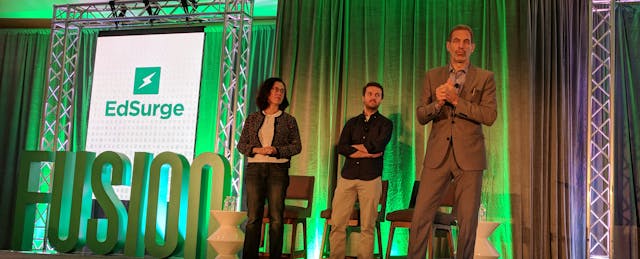Having a vision of the future requires—to some extent—understanding what the future will look like. Technologies like artificial intelligence and augmented reality have evolved “much faster than our civic infrastructure,” said Tom Vander Ark, chief executive of Getting Smart. “Our civic institutions are being swamped by questions that we’re not ready for.”
For education leaders, he said during his keynote at the EdSurge Fusion conference, those questions should include: How can our schools make room for kids to tackle challenges and opportunities attached to significant, undefined problems—and ask them to do work they don’t think they can do?
Throughout the day, technology industrialists joined school leaders at keynotes and workshops in grappling with how to best prepare students for a future where many jobs may be automated—and cease to exist.
“What I’m convinced of is that my granddaughter is going to face an order of magnitude [in terms of] more quantity and complexity—new and complicated stuff, headed in her direction,” said Vander Ark. “The gift that I can give her is confidence and humility to walk into complexity, knowing that she understands herself...and can walk into complicated situations knowing what to do first.”
Knowing what to do in a complex society requires both technical and soft skills, as noted by multiple attendees within the conference. Skills such as empathy, collaboration and team building, speakers noted, should be featured just as prominently as coding and computational thinking. And while technology can support the development of these skills, by no means is it a prerequisite.
“You certainly don’t want technology to beget more technology, which happens often,” said Benjamin Schrom, a Google product manager who created the virtual-reality gear Expeditions and shared the stage with Vander Ark. “What technology should do—when it’s working—is make more space not to use technology.” The more critical question, he says, becomes: “So what do you want to do with that time and space?”
For educators like Melissa Dodd, for whom time is a perpetually scarce resource, “technology can help create space for building relationships between people.” At a separate session, the chief technology officer of San Francisco Unified School District said that “students shouldn’t be in front of devices or using technology 24/7, because we want them to be engaging with each other, collaborating and problem-solving and developing their communication skills. Technology can be an enabler, but it’s about how to use it.”
An uncertain future is no excuse for unclear planning and uninformed technology purchases, however. And the unfortunate reality in many schools is that technology is often mis-used—or not used at all, according to Tom Murray. The director of innovation at Future Ready Schools insisted that educators must plan to use the resources they have wisely in order to prepare kids for the future. “I believe we actually waste more money on technology in schools, than technology that actually works,” he said during a workshop.

Challenging his peers to re-evaluate the technology they have purchased, Murray noted that many technologies merely teach students to be consumers, not creators. He offered an example of iPad-controlled robots that allow students to do minimal work to control the devices, and asked: How is that different from what many in the audience did with remote-controlled cars while growing up?
While auditing how districts use technology tools, he noticed major discrepancies between how many products were purchased—and how few were used. One district, Murray said, paid over $100,000 for a software program that only four teachers used.
“We need to make sure we have a vision and a plan when we are buying devices,” Murray told the crowd. “If we don’t have a 5- or 6-year vision, then where are we going?”
Enacting a coherent vision for technology implementation requires leadership. It’s a critical—but often overlooked—component, said Larry Schad, chief information technology officer at Houston Unified School District. That requires getting buy-in from the staff, which then requires much more effort than simply sending them to attend workshops to learn about new tools and devices.
“In education, organizational change management equates to training,” said Schad. Too often, he argued, the attitude towards staff development is: “‘Well, they don’t understand it, so just send them to more training.’ Well, guess what? If they don’t have the knowledge or desire to make this change, you can send them to 3,000 training classes, and they’re still going to walk away with [nothing].”
His fellow panelist concurred. “There are people with fear, people who are reluctant” to adopt new technologies, said Patricia Deklotz, Superintendent of Kettle Moraine School District in Wisconsin. “And it’s my obligation to create systems of support that move people along. It’s okay no matter where you’re at, as long as you’re moving. And tell us how we support you in that learning.”
The technical work involved in connecting software and devices “is the easy part,” Schad claimed. The harder challenge is “the emotional side of getting [teachers] to understand what’s in it for them, and making that understandable to the kids they teach.”


